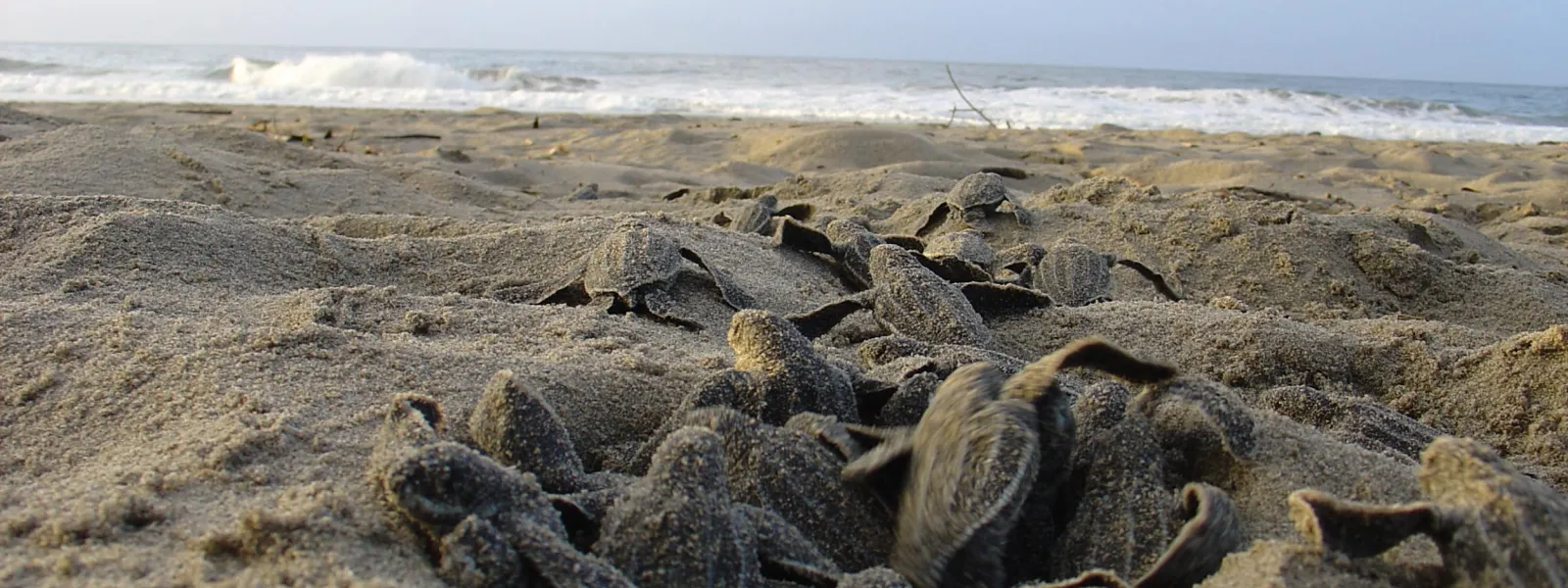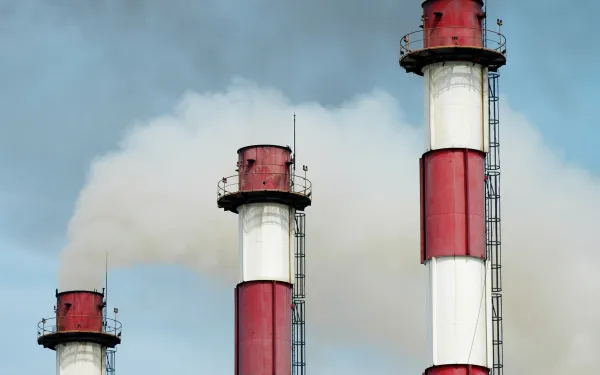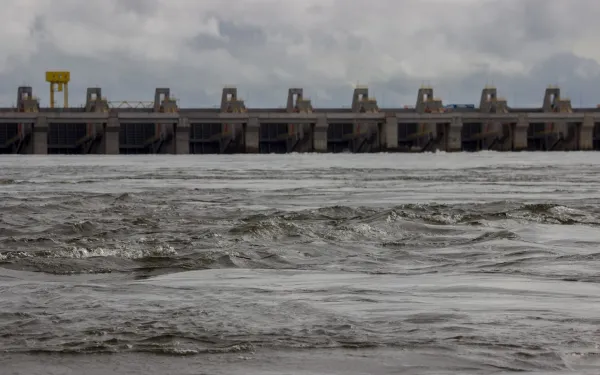
Project
Victory: Haven for leatherback sea turtles declared off-limits
In two separate rulings in May 2008, the Costa Rican government stood up for endangered leatherback sea turtles against business interests intent on building within their protected habitat.
A relative of dinosaurs, the endangered leatherback sea turtle has continually found its home in Costa Rica under threat. Poor planning and lack of oversight destroyed its nesting beaches in Flamingo and Tamarindo.
This time developers had their eye on the Leatherback National Marine Park (LNMP), home to some of the most important Leatherback nesting beaches in the Eastern Pacific Ocean.
A municipal zoning regulation was enacted that would authorize construction in part of the LNMP. However, AIDA and its local partner CEDARENA, together with the Leatherback Trust, successfully defended the park.
The Constitutional Chamber of the Costa Rican Supreme Court nullified the municipal zoning regulation, safeguarding the Leatherback sea turtles and their nesting beaches. This ruling closely followed another court victory by AIDA, CEDARENA, and Justice for Nature that required the government to expropriate the private lands within the LNMP, otherwise destined to be tourist playgrounds.
The leatherback sea turtle will continue to face threats from tourism development, fishing, egg poaching, and pollution. However, AIDA and its partners have shown that the law can be used to make a powerful difference.
Related projects

Controlling Short-Lived Climate Pollutants: An opportunity to better air quality and mitigate climate change
The report review the institutional, legislative, and regulatory frameworks, as well as existing government programs related to the control and monitoring of SLCPs, in three strategic countries of Latin America: Brazil, Chile and Mexico. Short-lived climate pollutants (SLCPs) are atmospheric agents that contribute to climate change and degrade air quality. They are so-named because of their relatively short lifespan in the atmosphere, ranging from a few days to a few decades. SLCPs include: black carbon, methane, tropospheric ozone, and hydrofluorocarbons. This report identifies areas of opportunity and potential gaps in which each of the three countries can make progress in mitigating these pollutants. Addressing these opportunities will benefit the fight against climate change, as well as the protection of ecosystems and human health. The report was made by the Interamerican Association for Environmental Defense (AIDA), in collaboration with the Instituto de Energia e Meio Ambiente (IEMA), and with the participation of the Centro de Derechos Humanos y Ambiente (CEDHA) of Argentina, and the Centro Mexicano de Derecho Ambiental (CEMDA), as well as the Red Latinoamericana de Contaminantes Climáticos de Corta Vida (RedRacc). Special thanks to Romina Picolotti of the Centro de Derechos Humanos y Ambiente (CEDHA); Laura Gallardo and Nicolás Huneeus of the Centro del Clima y Resiliencia de la Universidad de Chile; Gianni López of the Centro Mario Molina Chile; Gabriela Niño and Giselle García of the Centro Mexicano de Derecho Ambiental (CEMDA); Erika Rosenthal of Earthjustice; Sandra Guzmán of the Grupo de Financiamiento Climático para América Latina y el Caribe (GFLAC); Stela Herschmann of the Institute for Governance & Sustainable Development (IGSD); Evangelina Vormitagg of the Instituto Saúde e Sustentabilidade de Brasil; Marcelo Mena of the Ministerio de Medio Ambiente of Chile; Flavia Liberona and Javiera Valencia of the Fundación TERRAM of Chile; Luis Cifuentes of the Universidad Católica de Chile; Maria de Fatima Andrade and Paulo Hilário Nascimento Saldiva of the Universidad de São Paulo; and Sebastián Tolvett of the Universidad Técnico Metropolitana de Chile, for their comments and support. Read and download the report (in Spanish) Read and download the executive summart (available in English)
Read more
Water in Mexico: a human right, bottled
Mexico consumes 12 percent of the global volume of bottled water, highlighting the failures of the country’s water supply system and the violation of a basic human right. Nobody should be denied a glass of water. Serving your guests water is polite; it shows you have good manners and empathy for others. It is also, though not quite as obvious, an issue of human rights. In Mexico’s capital, until only recently, restaurants could deny a glass of water to their customers and require them to drink only bottled water. On one occasion, the owner of a gourmet pizzeria reacted furiously when she saw my boyfriend take out his own water bottle to take a pill. She told him it was prohibited to bring outside food and drink into her restaurant. Then, when we asked for a glass of water, she responded angrily: “We don’t give water away here, we sell it in bottles.” A circular business What you find being sold in supermarkets is not the water, but the bottle. In Mexico, the cost of the extraction and supply of water is relatively low, since almost the entire service is subsidized. According to the highest available rate, a glass of water costs seven cents (.007 Mexican pesos). For a bottle with the same quantity of water, the pizzeria charged $1.50 (28 pesos), seven times the supermarket price. The incident in the pizzeria occurred after the Legislative Assembly of Mexico City required food establishments to provide free glasses of water to customers who ask for it. But even after the legislative provision, I have often had to clarify that I want a glass of water, not a bottle. The waiters often warn me, “It’s filtered water,” reminding me of its unreliability. The dynamic behind this type of business has changed: they now buy large jugs of bottled water or spend money on filters, because in Mexico it’s well known that you never drink water directly from the tap. It’s an unspoken secret, almost popular belief, that tap water is dirty water. It’s common that even those of us who don’t buy bottled water have a filter in our homes. This belief emerged from the 1985 earthquake, when various pipes broke and drinking water mixed with sewage. Later, during a cholera epidemic in the 1990’s, the government promoted chlorinating or boiling the tap water. Yet no authority was responsible for the quality of the pipes through which the drinking water ran; water which, by definition, should be fit for human consumption. In contrast, Chile promotes three reliable water sources: chlorinated, boiled or taken from the tap. In Mexico, the health threat coincided with the arrival of bottled water. What the companies promoted in those early years was confidence and security in the quality of their water. So, little by little, we went from boiling and chlorinating our water, to buying it in 20-liter jugs, to buying small plastic bottles that hold less than 250 ml of water. According to the International Bottled Water Association (IBWA), in 2014 Mexicans consumed 253 liters of bottled water per person. This compares to 94.3 liters per person in Europe (where public drinking fountains are commonplace) and 37 liters per person globally. Mexico consumes 12 percent of the world’s total volume of bottled water. The World Bank cites 80 percent of the Mexican population as distrustful of the water supply system. Bottled water companies, then, have nothing but room to grow, especially considering the majority of the population doesn’t yet consume the recommended two liters of water per day. And a large quantity of bottled water is used on daily tasks such as cooking and washing dishes, even on bathing newborn babies. Can you or can’t you drink tap water? The answer is: It depends. The responsibility for water supply in Mexico is so fractioned that it’s impossible to get a convincing response. In the capital city, water quality is disclosed each year and in only two neighborhoods does it not meet standards for human consumption. Unfortunately, those with the worst water quality also have the lowest standard of living. Information on the subject doesn’t arrive to our homes, it’s difficult to access and – in some cases – the information is non-existent, hidden or disguised. No government authority is responsible for water quality: not the National Water Commission, not state or city governments. Violating a human right Without convincing responses about the reliability of the water supply system, Mexicans are opting to buy bottled water. By doing so, we’re demonstrating that something is wrong with the country’s water system, and the human right to water is not guaranteed. According to the UN, drinking water must be safe, clean accessible and affordable for all. The human right to water was included in the Mexican Constitution four years ago, but its implementation, and the party responsible for guaranteeing it, remains under discussion. While the debate continues, millions of Mexicans are, understandably, buying bottled water to protect their health. The lack of information about or accountability for the water supply system makes the guarantee of this human right nothing more than a dream. The UN established that people shouldn’t spend more than three percent of their income on water services. In Mexico, only those with incomes greater than $1,200 a month (21,000 pesos) spend three percent or less of their income on bottled water. The other 80 percent of households in the country spend as much as eight percent, a staggering figure, especially considering it doesn’t include what they pay for water used for other domestic activities. People are buying bottled water because they don’t trust the country’s water supply system. By denying a glass of water to its population, the Mexican government is denying a fundamental human right.
Read more
Belo Monte: the river may be dying but the search for justice never will
“The river is dead!” exclaimed Raimundo as we navigated in his motorboat from Altamira toward the big bend of the Xingu River. From my perch in Raimundo’s boat, it was easy to see how bleak the landscape surrounding Altamira—the northern Brazilian city closest to the construction of the Belo Monte Dam—has become. The big island of Arapujá, located across from Altamira, has been completely deforested, causing a radical change in the currents of the river. Many of the smaller islands, previously inhabited by fishermen, are now completely submerged, only the tops of trees visible above the rising water. I visited Altamira, and the indigenous and riverine communities nearby, with colleagues from Justiça Global. We came to update our case, and to inform those affected by Belo Monte of a new hope for justice: in December, the Inter-American Commission on Human Rights opened the case against Brazil for human rights violations caused by the dam. In January, Norte Energía, the company charged with the construction and operation of Belo Monte, opened the dam’s floodgates without warning communities living downstream. They say the Xingu grew seven meters in just an hour. In some communities, the rising water flooded their riverside land, taking with it canoes, boats and items of clothing. Destroying lives The boat took us to a spot in the river where a large island once stood with a house in the middle. Raimundo Nonato had lived there. He raised animals and dedicated his life to fishing. It had been the perfect place to bathe in the river. It was there, in 2013, that Antonia Melo, leader of Movimento Xingu Vivo Para Siempre, baptized me as a defender of these waters. Now the island is under water, and all that remains to be seen are the tops of some fruit trees. Leoncio Arara, an indigenous man from the community Arara da Volta Grande, says his community lives in fear of the river’s expected growth, the loss of their culture and way of life, and from the recent death of 16 tons of fish. They have seen cracks in the dike of the dam’s bypass channel and fear it will break, as the Fundão mining waste dam did in Minas Gerais. On our tour of the area, we also noticed discolored patches on the dike, which should certainly be a sign of alarm. Leoncio said the fear keeps him up at night. On the indigenous lands of the Arara da Volta Grande and Paquiçamba, the life of inhabitants has changed radically. They must now travel to the city (Altamira) to sell their harvest and to buy food. The changing environment has drastrically reduced opportunities for fishing and hunting, rendering their traditional subsistence lifestyle inadequate. Leoncio says that his peoples’ traditional knowledge and community life are being lost. Their homes are different, as is the formation of their village. Norte Energía has carelessly constructed houses that conflict with their culture, because of the location and materials used. Their community lacks even a well from which to retrieve drinking water, a condition that should have been met more than five years ago. Pain, injustice and struggle On our trip, we spent nine days in the area around the Belo Monte dam. We listened to so many stories of pain and injustice: of indigenous children that died from bad medical care in villages without access to the city; of indigenous people who left their villages to seek shelter in the city and now live in the overcrowded Casa del Indio, surrounded by filth and, often, conflicting ethnic groups. We relived the stories of tireless struggle, like that of Socorro Arara, an indigenous woman whose home was destroyed, along with those of her relatives. Socorro and her family all had to haggle with the company, as if their basic human rights were negotiable. Some received very little money in compensation, others the option of a prefabricated house in a neighborhood far from the river. Socorro’s parents live in one of those neighborhoods. Behind their new cement house, they built a small home with the wood they were able to save from their destroyed home. It is there that they really live, by the light of small kerosene lamps, sleeping in hammocks. Electricity is not part of their lives. Residents of Altamira live surrounded by the ironies of the third largest dam in the world. On February 28, Altamira and various cities in the state of Para were left without electricity. The cutoff, described by the receptionist at our hotel as routine, was due to testing on one of the dam’s turbines. There’s not much time now until the Belo Monte begins operation. If, for the countries of the region, Belo Monte represents the cherished dream of development, for me it represents a nightmare from which I’m dying to awake. It’s a nightmare of pain and human rights violations, in which a beautiful, living river is quickly fading away. Going with it are the lives and the dreams of those who have long depended upon its clean and healthy waters. Human rights are not negotiable. The victims of Belo Monte need justice now! It is that dream of justice that I hope, one day soon, becomes reality. -- I wrote these lines in honor of all the people who have dedicated their lives to defending our rivers and our life.
Read more